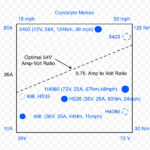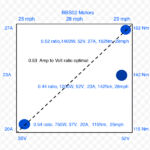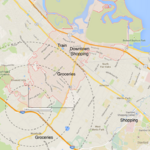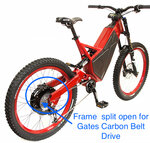Mike leroy
Active Member
Which motor best suits your riding style? Is it possible that a simple switch can convert the same bike from a legal 20mph "bicycle" to a 40+ mph motorcycle? Yes. Four Crystalyte rear hub motors are compared to illustrate the relationship between power(W), speed(mph), torque(Nm), volts(V) and amps(A). Three 8Fun BBS02 center-mounted motor are also compared in the same manner.
The conclusion is the most flexible solution is a 27Amp, 72Volt, 1944Watt controller, compatible with two 13 Amp-hour, 37V battery packs. Certainly, a 72V, 27A, 1944W system is fun for off-road use. Switching the 72V series connection between two 37V volt battery packs to a parallel connection would convert the battery packs from a 72V, 13 Amp-hour into a 37V, 26 Amp-hour power supply. A flexible switch allows a fun, powerful off-road to be instantly converted to a CA legal bicycle. The 37V, 1000W controller switch permits access in CA to bicycle paths as "motorized bicycle".
Unfortunately, the 8Fun BBS02 controller is currently limited to 60V. I encourage bicycle manufacturers to develop a flexible 36-72V switchable controller, as displayed in the following diagram. The idea cannot be patented, because by virtue of appearing here, "prior art" has been established.

The following graph illustrates the conceptual relationships. Torque, an indication of hill-climbing power, is presented in Newton-meters(Nm), rather than foot-pounds. The solid color dots chart torque against speed. The dotted circles illustrate the amp to volt ratios.
The dotted line in previous graph represents my idealized watt ratio. Each watt has three parts amps and four parts volts. Amps are correlated with hill-climbing power. Volts loosely relates to speed and acceleration. Think of the ratio as a cup of coffee. How much cream and sugar suits your taste?
In other words, a 36 volt, 9 amp, 350 watt EuroMotor just ain't my cup of tea -- about half my desired amp ratio. My favorite motor in the following graph is the 4200 watt 5403, but unfortunately is too heavy. My ideal choice is a 27 amp, 36 volt BBS02, which is three times EuroMotor amperage.
The 8Fun BBS02 center-mounted motor is contrasted with hub motors in the following picture. The optimal amp-to-volt ratio for the BBS02 is 0.53.
My pedal strategy is to exploit motor power to overcome sub-20mph speeds. I will use a 50 tooth chainring to achieve high, leg-powered speeds over 20mph without motor assistance. I am primarily concerned with accelerating past inattentive car traffic and easing steep hill climbs. My goal is an average 25mph speed in a three mile radius. The most frequent trips are transportation related, e.g., grocery shopping, train connections, etc....
Motor weight, or torque-to-weight ratio, is the reason I chose a center-mounted motor over hub motors. The Crystalyte 5403 weighs 30 kg, or 7.5 times the BBS02, for the same 120Nm torque. The higher weight comes from more powerful, thicker magnets and copper wire in the hub motor. The center-mounted BBS02 relies on gears to run at the most efficient RPM, rather than stronger magnets.
The 5403 also uses the more expensive 72V battery pack to achieve higher power, which costs $1200 more for the 26 amp-hour pack.
In California, 1000 watts is the legal limit for "motorized bicycles". Since the motor is restricted to 1000 watts of electrical power, my goal is to find the motor that generates the greatest torque for 1000 watts. In CA, 1001 to 1500 (2 HP) is a M2 scooter, which is prohibited from bicycle paths.
The constraints I choose to accept are a maximum 54 volts and 27 amps. Therefore, optimizing the bike gearing is crucial for a satisfactory outcome. Configure the highest gear ratio possible with Rohloff Integrated Gear Hub (IGH) to pedal the largest chainring my legs can tolerate.
Some of the reasons I chose the following frame are:
The conclusion is the most flexible solution is a 27Amp, 72Volt, 1944Watt controller, compatible with two 13 Amp-hour, 37V battery packs. Certainly, a 72V, 27A, 1944W system is fun for off-road use. Switching the 72V series connection between two 37V volt battery packs to a parallel connection would convert the battery packs from a 72V, 13 Amp-hour into a 37V, 26 Amp-hour power supply. A flexible switch allows a fun, powerful off-road to be instantly converted to a CA legal bicycle. The 37V, 1000W controller switch permits access in CA to bicycle paths as "motorized bicycle".
Unfortunately, the 8Fun BBS02 controller is currently limited to 60V. I encourage bicycle manufacturers to develop a flexible 36-72V switchable controller, as displayed in the following diagram. The idea cannot be patented, because by virtue of appearing here, "prior art" has been established.
The following graph illustrates the conceptual relationships. Torque, an indication of hill-climbing power, is presented in Newton-meters(Nm), rather than foot-pounds. The solid color dots chart torque against speed. The dotted circles illustrate the amp to volt ratios.
The dotted line in previous graph represents my idealized watt ratio. Each watt has three parts amps and four parts volts. Amps are correlated with hill-climbing power. Volts loosely relates to speed and acceleration. Think of the ratio as a cup of coffee. How much cream and sugar suits your taste?
In other words, a 36 volt, 9 amp, 350 watt EuroMotor just ain't my cup of tea -- about half my desired amp ratio. My favorite motor in the following graph is the 4200 watt 5403, but unfortunately is too heavy. My ideal choice is a 27 amp, 36 volt BBS02, which is three times EuroMotor amperage.
The 8Fun BBS02 center-mounted motor is contrasted with hub motors in the following picture. The optimal amp-to-volt ratio for the BBS02 is 0.53.
My pedal strategy is to exploit motor power to overcome sub-20mph speeds. I will use a 50 tooth chainring to achieve high, leg-powered speeds over 20mph without motor assistance. I am primarily concerned with accelerating past inattentive car traffic and easing steep hill climbs. My goal is an average 25mph speed in a three mile radius. The most frequent trips are transportation related, e.g., grocery shopping, train connections, etc....
Motor weight, or torque-to-weight ratio, is the reason I chose a center-mounted motor over hub motors. The Crystalyte 5403 weighs 30 kg, or 7.5 times the BBS02, for the same 120Nm torque. The higher weight comes from more powerful, thicker magnets and copper wire in the hub motor. The center-mounted BBS02 relies on gears to run at the most efficient RPM, rather than stronger magnets.
The 5403 also uses the more expensive 72V battery pack to achieve higher power, which costs $1200 more for the 26 amp-hour pack.
In California, 1000 watts is the legal limit for "motorized bicycles". Since the motor is restricted to 1000 watts of electrical power, my goal is to find the motor that generates the greatest torque for 1000 watts. In CA, 1001 to 1500 (2 HP) is a M2 scooter, which is prohibited from bicycle paths.
The constraints I choose to accept are a maximum 54 volts and 27 amps. Therefore, optimizing the bike gearing is crucial for a satisfactory outcome. Configure the highest gear ratio possible with Rohloff Integrated Gear Hub (IGH) to pedal the largest chainring my legs can tolerate.
- Conceptually the Gates Carbon Drive front/rear sprockets are like a BMX no-gear bike.
- The IGH provides gearing. The front/rear on a BMX is approximately 27:9, or 3:1. The Gates 55:19 is closest at 2.8:1 . Use this chart and calculations for the previous PDF doc to customize for your situation.
- I probably need about a 1.6m display, so a 50:20 (2.5:1) is probably the closest match for my fitness level.
Some of the reasons I chose the following frame are:
- Split frame for belt and chain compatibility. Frame weighs only weighs 19 pounds.
- The battery tank capacity is enormous, 26 Amp-hours! 52V, 26Ah NMC battery pack only weighs 16 pounds, but costs $1900.
- The swingarm suspension for safe driving at 45+ mph downhill coasting speeds in two-lane traffic. My neighborhood also has 15mph speed bumps on hills with 30mph downhill coasting speeds. I will also take dirt paths that cut across residential streets. About ten concrete curbs meet the dirt paths at the street intersections. The ride is jarring. The 40mph downhill, potholed, tree-rooted, backroads are in a state of disrepair. My favorite backroad is one that I take, every chance I get.
- Either a mid-drive or rear hub motor up to 6000 Watts can be installed. The bottom bracket is a generic standard, rather than a proprietary brand.
- Must weight under 50 pounds to meet Amtrak regulations. Weight without front wheel and battery pack.
- In California, 1000 watts is the legal limit for "motorized bicycles". Since the motor is restricted to 1000 watts of electrical power, my goal is to find the motor that generates the greatest torque for 1000 watts. The 750w BBS02 generates 115Nm of torque.
- Has a throttle. Controller has adjustable 20mph cut-off. I also want the flexibility to upgrade to 45+ mph rear hub, if the side roads do not work out.
- All wires routed internally.
- U.S. DOT VIN number to register in CA as legal motorcycle, should I choose that option.
- A mail-order and service bike, so components must be the most reliable.
- Configure the highest gear ratio possible with Rohloff IGH to pedal the largest chainring my legs can tolerate. My strategy is to rely on motor to power me through sub 20mph speeds. I will use a 50 tooth chainring to achieve speeds over 20mph without motor power.
- Conceptually the Gates Carbon Drive front/rear sprockets are like a BMX no-gear bike.
- The IGH provides gearing. The front/rear on a BMX is approximately 27:9, or 3:1. The Gates 55:19 is closest at 2.8:1 . Use this chart and calculations for the previous PDF doc to customize for your situation.
- I probably need about a 1.6m display, so a 50:20 (2.5:1) is probably the closest match for my fitness level.
Last edited:



